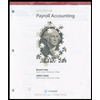
Concept explainers
Introduction:
Assets: Assets are those items that provide value for money and future economic benefit for an organization. Assets of an organization may be in these two forms: Tangible or intangible form. Examples: Cash, Short-term investments, Inventories,
Liabilities: Liabilities are obligations of the business. These are the claims against the resources that a business owes to outsiders of the company. Liabilities may be Current liabilities, and Long-term liabilities. Examples: Creditors, Bills payable, Bank overdraft, Salaries and wages payable, and Notes payable.
Expenses: Expenses are the costs that companies borne to produce and sell the goods and services to the customers or clients. Examples: Utilities expense, Salaries expense, advertising expenses.
Revenues: Revenues are the income or earnings that a company receives for delivery of goods and services. Examples: Service revenue, Interest revenue, Fees earned.
Common stock: Common stock is an owners’ claim to the assets of the company.
To Classify: The elements of financial statements.
Want to see the full answer?
Check out a sample textbook solution
Chapter 1 Solutions
FINANCIAL ACCT.:TOOLS...(LL)-W/ACCESS
- Which of these transactions would be part of the operating section? A. land purchased, with note payable B. sales of product, for cash C. cash paid for purchase of equipment D. dividend payments to shareholders, paid in casharrow_forwardThe balance sheet lists which of the following? A. assets, liabilities, and owners equity B. revenues, expenses, gains, and losses C. assets, liabilities, and investments by owners D. revenues, expenses, gains, and distributions to ownersarrow_forwardFINANCIAL STATEMENT ACCOUNTS Label each of the following accounts as an asset (A), liability (L), owners equity (OE), revenue (R), or expense (E). Indicate the financial statement on which the account belongsincome statement (IS), statement of owners equity (SOE), or balance sheet (BS)in a format similar to the following.arrow_forward
- FINANCIAL STATEMENT ACCOUNTS Label each of the following accounts as an asset (A), liability (L), owners equity (OE), revenue (R), or expense (E). Indicate the financial statement on which the account belongsincome statement (IS), statement of owners equity (SOE), or balance sheet (BS)in a format similar to the following.arrow_forwardConsider the following accounts, and determine if the account is an asset (A), a liability (L), or equity (E). A. Accounts Payable B. Cash C. Dividends D. Notes Payablearrow_forwardWhich of these transactions would be part of the financing section? A. inventory purchased for cash B. sales of product, for cash C. cash paid for purchase of equipment D. dividend payments to shareholders, paid in casharrow_forward
- Consider the following accounts and determine if the account is an asset (A), a liability (L), or equity (E). A. Accounts Receivable B. Sales Revenue C. Land D. Unearned Revenuearrow_forwardIdentify the correct components of the income statement. A. revenues, losses, expenses, and gains B. assets, liabilities, and owners equity C. revenues, expenses, investments by owners, distributions to owners D. assets, liabilities, and dividendsarrow_forwardIdentify the financial statement on which each of the following accounts would appear: the income statement (IS), the retained earnings statement (RE), or the Balance Sheet (BS). A. Insurance Expense B. Accounts Receivable C. Office Supplies D. Sales Revenue E. Common Stock F. Notes Payablearrow_forward
- Determine on which financial statement each account listed below is reported. Use the following abbreviations: Income Statement (IS), Statement of Owners Equity (OE), and Balance Sheet (BS). a. S. Beagle, Capital b. Cash c. Miscellaneous Expense d. Accumulated Depreciation, Equipment e. Wages Payable f. S. Beagle, Drawing g. Equipment h. Supplies i. Depreciation Expense j. Supplies Expense k. Service Fees l. Accounts Receivablearrow_forwardClassification of Financial Statement Items Classify each of the following items according to (1) whether it belongs on the income statement (IS) or balance sheet (BS) and (2) whether it is a revenue (R), expense (E), asset (A), liability (L), or stockholders equity (SE) item.arrow_forwardIdentify whether each of the following accounts would be considered a permanent account (yes/no) and which financial statement it would be reported on (Balance Sheet, Income Statement, or Retained Earnings Statement). A. Common Stock B. Dividends C. Dividends Payable D. Equipment E. Income Tax Expense F. Income Tax Payable G. Service Revenue H. Unearned Service Revenue I. Net Incomearrow_forward
 College Accounting, Chapters 1-27AccountingISBN:9781337794756Author:HEINTZ, James A.Publisher:Cengage Learning,Principles of Accounting Volume 1AccountingISBN:9781947172685Author:OpenStaxPublisher:OpenStax College
College Accounting, Chapters 1-27AccountingISBN:9781337794756Author:HEINTZ, James A.Publisher:Cengage Learning,Principles of Accounting Volume 1AccountingISBN:9781947172685Author:OpenStaxPublisher:OpenStax College College Accounting (Book Only): A Career ApproachAccountingISBN:9781305084087Author:Cathy J. ScottPublisher:Cengage Learning
College Accounting (Book Only): A Career ApproachAccountingISBN:9781305084087Author:Cathy J. ScottPublisher:Cengage Learning
 Financial Accounting: The Impact on Decision Make...AccountingISBN:9781305654174Author:Gary A. Porter, Curtis L. NortonPublisher:Cengage Learning
Financial Accounting: The Impact on Decision Make...AccountingISBN:9781305654174Author:Gary A. Porter, Curtis L. NortonPublisher:Cengage Learning





